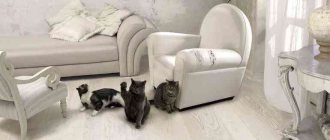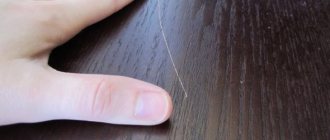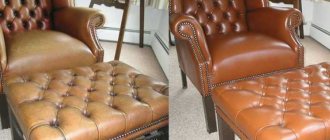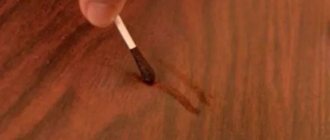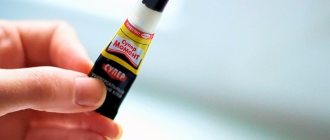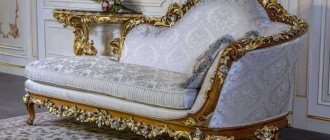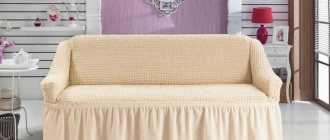Leather furniture is always beautiful, is an indicator of wealth and does not go out of fashion. It is for these reasons that many people prefer leather in the interior. This kind of chairs and sofas will decorate your room for many years. But leather products have a big drawback - scratches. Unfortunately, your sofa may become covered with them over time. Especially if there are pets in the house. Therefore, if you decide to upgrade the product, it is important to know how to remove scratches from a leather sofa.
What you can use to fix the problem depends only on what you have on hand. Most of the materials that can be used are available in every home.
Leather furniture often comes with a small piece of leather so you can see what material it's made of and can also be used if a cut occurs. If such a piece is included, do not throw it away, save it, it will come in handy.
Olive oil
Damage can be removed with olive oil. Use the one you use in cooking, or buy the cheapest one. Before using the oil, try applying it to a piece of leather that came with the product or similar fabric and see the effect. If the surface has not deteriorated, you can proceed to the sofa.
damage
You will need olive oil and cotton wool. Apply the oil to the scratches and the area around them, then begin to rub in with a cotton swab in a circular motion. Wait until the skin dries, this will take about 40 minutes, but no more than an hour and a half.
If the cut was not too deep, it will disappear, if not, then do the same 2-3 times, this amount is enough to have a good result.
How to stop a cat from tearing up furniture or a sofa using humane methods?
Often, upon reaching a certain age, a kitten begins to sharpen its claws on surrounding objects, which leads to their gradual deterioration. There are many methods for stopping a cat from scratching a sofa, favorite chair, ottomans or cabinet doors.
The main thing is not to try to explain to the animal that this cannot be done. The options advertised by many involving spraying the cat with water or shouting loudly will not help protect the furniture.
They will only provoke aggression on the part of the kitten, who, at best, will begin to scratch something else, but no less valuable.
You should immediately take into account that the animal will not stop sharpening its claws; this is a natural process that has a positive effect on the physical and mental state of the pet. On the one hand, the cat marks its territory in this way, establishing itself as a full-fledged resident of the apartment. Often cats deliberately tear at the owner’s favorite place, thereby showing their location. And in some cases, this is the only way to improve the condition of worn-out claws.
Which cats don't tear up furniture - the pros and cons of radical approaches
Contrary to popular belief, the breed of the cat does not matter in this area. Regardless of whether there is an aggressive Siamese cat, a calm Maine Coon or an exotic Sphynx living at home, the furniture is in the same danger.
Sterilization will also not play a decisive role; even a calmed pet will not give up its favorite habit. If an animal spoils products from time to time, this may be the result of poor quality care for its claws.
In this case, it is recommended to visit a veterinarian and find out how to carry out basic manipulations.
Most often, a stubborn animal constantly destroys furniture. In this case, the owners, driven to white heat, sometimes resort to radical methods to solve the problem. To ensure that the pet never scratches anything again, they agree to do one of the following procedures:
- Complete declawing.
- Cutting tendons, which prevents the ability to extend claws.
- Regular trimming of elements.
All of the above methods literally lead to disability of the cat. The animal's posture deteriorates and coordination is impaired, which is accompanied by serious stress. You shouldn’t be surprised if, after such an aggressive approach, you find that your pet is now chewing on shoes, furniture, and everything else it comes across.
Humane and effective ways to wean cats from destructive habits
After radical methods have been discarded, you can begin to search for a suitable way out of the situation. The best place to start is by providing your home pest with a quality replacement in the form of a scratching post. Moreover, this should be done at the first sign that the pet has taken a fancy to a leather sofa or soft chair, before he strips the item down to its filling.
The cat himself will not sharpen his claws on a new, incomprehensible product; a lot will have to be done for him to understand that the replacement is equivalent:
- First, the product can be leaned against the piece of furniture that the animal is purposefully damaging.
- Additionally, it is worth taking the cat by the paw and gently moving it along the surface with a high level of tension and resistance. Cats like to scratch precisely these areas, so sometimes even one practical lesson is enough.
- Affection is pleasant even for a cat, so every time you need to praise an animal that independently chose a scratching post rather than furniture.
In addition to providing something to sharpen its claws on, you need to make sure that your cat loses interest in anything he previously scratched. Otherwise, you may encounter a situation in which the animal eats everything indiscriminately.
- You can use citrus essential oils to stop it from scratching your favorite leather sofa. Just a few drops, rubbed over the surface of the upholstery or diluted in a large amount of water and sprayed over its surface, will drive away a stubborn animal. You just need to remember to update the smell.
Advice: At the same time, it is worth stimulating the cat’s interest in the scratching post. To do this, add a few drops of valerian or catnip onto the product.
- Cats hate it when their claws and paws stick to the surface they are scratching. A few strips of double-sided tape will quickly cool the animal's interest in the furniture. True, this is recommended to be done only in the case of a leather item; the fabric noticeably deteriorates from the prolonged presence of glue on it.
- Silicone attachments are gaining particular popularity in the fight against cats who like to sharpen their claws. They are attached to natural elements using animal-safe glue. The only inconvenience is that the nozzles will have to be changed regularly. And this technique will not help if the animal not only scratches, but also gnaws the surface.
In extreme cases, you can get by with covers. They are best made from soft fabric and folded. For a cat to scratch the surface, it must be dense. If an animal tears at the fabric, but it gathers in waves and does not stretch, it will quickly lose interest in the area.
What to do if a cat scratches a leather sofa?
If time has been lost and the cat has thoroughly torn up the furniture upholstered in fabric, restoring a specific area using the same material or an original decorative insert can help. A leather sofa cannot be restored so easily; you can only mask shallow scratches on your own. In case of serious damage, it is better not to try to do anything at home, but to immediately contact a professional.
- Olive oil. The use of this component can save, even if the animal prefers to sharpen its claws on light skin. It is first recommended to test the method on an inconspicuous area of the material and only then begin restoration. Take slightly warm olive oil and a thick cotton pad. We soak the cotton wool in the oil, squeeze it out thoroughly, and gently wipe the scratch itself and small areas of skin around it. We work in a circular motion in one direction. After this, we wait until the composition dries and evaluate the work. In some cases, a scratch may disappear without leaving a trace after just one treatment. If necessary, repeat the manipulation.
- If a cat slightly scratches a dark leather sofa, it is better to use shoe polish. We select the product of the required shade, apply it to a cotton swab and carefully rub it into the damaged surface. We wait until the mixture dries and wipe the area with a clean paper napkin. We evaluate the work and, if necessary, make several more approaches.
- If the furniture is covered with deep scratches, you will have to do the following. We use the oil approach first (regardless of the color of the material). Then we treat the area with oil again, put a cotton cloth on it and wait for the liquid to be absorbed into it. After this, we take a new piece of fabric, moisten it with water and apply it to the damaged area. Iron the flap with a warm iron, holding it for no more than 8-10 seconds. If necessary, repeat several times. From this effect, the oil will be absorbed better, masking the scratches.
Olive oil, cotton cloth and iron
If the scratch is deep and does not disappear, you will have to put in a little more effort to get rid of it. Apply olive oil to the same area again. Take a cotton cloth, lay it down until all the liquid is absorbed, then remove the cloth.
After the skin dries, the scratch disappears. If the damage remains, place the wet cloth in the same place and iron it with a warm (not hot!) iron for 10 seconds, no more. It is important to move the iron and not hold it, otherwise you can ruin the sofa even more. If necessary, repeat again. Oil is better absorbed when interacting with moisture and heat.
How to remove scratches from a leather sofa
Here are some popular methods that will tell you how to restore a leather sofa from cat scratches.
Olive oil
Before you start restoring furniture that was torn up by a cat, you need to check the reaction of the sofa leather to the oil. To do this, apply oil to an area that is invisible to the eye and wait a while. If the skin has not lost its shine, this method is suitable.
We wet the sofa with oil and then polish it well with a cloth.
What to do:
- dip a cotton pad or cotton swab into the oil;
- wipe the scratch area, slightly going beyond it;
- let dry;
- repeat the procedure if necessary.
This method perfectly removes shallow scratches.
Iron, textiles and oil
If the first method was not effective enough, you can try an “improved” version of the method. In addition to oil, you will need a cloth and an iron.
How to do:
- lubricate the damaged area with oil;
- apply cloth to the scratch;
- wait until the oil is absorbed into the fabric and remove it.
If the cat scratched the sofa shallowly, the traces of the cat’s crime will disappear after the first manipulation with the oil.
Did not help? The second part of the method should solve the problem:
- take the same piece of cloth, moisten it with water;
- apply to the damaged area;
- wait until the water is absorbed a little;
- take a warm (precisely warm) iron;
- iron the fabric for 10 seconds;
- repeat until effect is achieved.
This method allows you to cope even with deep scratches. It is worth considering that 2-3 repetitions are necessary to remove some damage.
If the tracks lie deeper than expected, the steps described above will have to be repeated three to four times.
Shoe polish
Sometimes an old, perhaps slightly forgotten remedy comes to the rescue: shoe polish. Products intended for natural leather have an oily base and thick texture. They can be useful in repairing furniture. The most important thing is that the shade of the upholstery and the product matches. As a last resort, you can mix two different shades to get the desired one.
The shoe polish should match the shade of the leather sofa.
How to repair scratches on a leather sofa using shoe polish:
- apply a small amount of cream to a cotton swab;
- Rub it into the scratched area in a circular motion.
It is better to soak the remaining cream with a napkin. This method is suitable if the cat decides to sharpen its claws on the bottom or side bar. It is not recommended to remove scratches on the seat using this method.
If the color of the cream is chosen correctly, you will be able to perfectly disguise scratches on the surface of the sofa.
Rubber glue
Rubber glue, which does not contain acetone, is suitable for this purpose. It will fill in the damaged areas and the sofa will be restored. Carefully fill the scratch area with glue. This can be done with a toothpick so as not to leave marks on “healthy” areas of the furniture. When the glue dries, the strip is painted over with a matching marker or wiped with shoe polish.
When the scratch is sealed, paint over the damaged area on the sofa with a special paint that matches the color of the leather furniture.
Nail polish
There are two difficult points in this method: you need to choose a varnish of the same shade and texture as the sofa, and also apply it very carefully. The easiest way to “fix” a black glossy sofa in this way.
For matte skin, matte varnish is suitable.
Instead of a standard brush, it is better to use a toothpick or a special brush for drawing on nails. The varnish is applied in a thin strip, strictly into the scratch.
You can use nail polish of a suitable color.
Marker
The most suitable would be a waterproof marker (for example, for drawing on glass). It is matched to the tone of the sofa. In order not to make a mistake with the color, you can take a piece of upholstery or take a photo of the sofa. The color rendering of the smartphone should be adjusted as well as possible: furniture should be photographed in sufficient daylight. The marker is used in the same way as varnish or shoe polish: it is applied strictly to the scratch. If the cut is deep, you can first fill it with rubber cement.
You can quickly veil the scratch with a marker of a suitable shade.
Wax
What to do if the cat scratched the leather sofa quite deeply? In this case, you should arm yourself with wax. Natural bee or special furniture material will do. The product is heated in a water bath or in the microwave (10-20 seconds is enough, depending on the power). Then, using a soft cloth or cotton pad, apply to the damaged area. It is best to take flannel - it is a very soft and delicate fabric that is suitable for polishing.
Wax can also help fill damaged areas on leather upholstery, only a special one - for leather or bee wax.
After the wax hardens, the scratch will be invisible. This method is universal: it is suitable for upholstery made of genuine leather, and for dermantin or eco-leather.
Liquid skin
It is better to remove damage in the most visible places using liquid skin. You can buy it in specialized stores that sell building materials or leather goods.
This composition, reminiscent of gouache in consistency, is sold in sets of several colors or individually.
Apply the product with a soft sponge using patting movements. When the liquid skin is completely dry, the damage will not be visible. This method is suitable for all types of leather: natural and leatherette. Again, the most important thing is to choose the right shade.
If your furniture is a non-standard color, you will have to buy several of the desired colors in order to achieve the desired shade by mixing.
Shoe polish
You can also remove it with shoe polish. You must choose the right color. There are many different shades of creams on the market. If you couldn’t find the right one, try mixing two creams until the desired color comes out. But this method is used only for small and not too deep cuts; it only masks the scratch and does not remove it forever.
Apply the cream to cotton wool and rub into the area where needed. If the color is well chosen, the scratch will become invisible. When choosing this method, be prepared that the shade may be slightly different, so it is better to use this method on that part of the sofa that is not noticeable.
Before and after
How to wean an animal
If there is a cat in the house whose paws are constantly itching, then you need to purchase a special scratching post for him. But, unfortunately, not all animals take it seriously, and in this case we have to look for new ways and solutions to eliminate this problem.
To begin with, you can make a small cape or cover for the sofa. If a cat picks him up too, then it doesn’t matter what she sharpens her claws on, the main thing is that this thing is in this exact place. Then remove the cape and place a scratching post near this place, slightly blocking the sofa. The animal will quickly get used to the new piece of furniture and will stop trying to spoil the owners’ furniture.
If the new cover does not interest her at all, then she needs exactly the same material as on the sofa. Some owners make special toys from leatherette; such distraction helps the animal become good.
Liquid skin
If you have time to wait, the easiest method of all listed will do. Liquid leather is sold both in regular hardware stores and in online stores. If the color of the product is rare, order the product on the Internet, there is more choice. Stores stock basic colors such as black and white. Liquid skin may remind you of gouache. Apply it evenly to the damaged area, do not forget to press with a sponge to create relief on the skin. Wait until it dries and enjoy the result.
We recommend reading the article about how to give a second life to your favorite mattress.
No matter how many effective ways there are to repair furniture, try to handle it carefully and protect it from various damages, including from your favorite animals, so as not to create unnecessary work for yourself in removing scratches and sometimes even cuts. But if you still couldn’t save it, choose the most suitable method from those presented; they are all effective for various types of damage.
Patches and applications
What to do if the furniture is not just scratched, but also torn to shreds? The most basic option is reupholstery, but this is not always available, so patches or appliques can help out in this situation. You can use a patch on inconspicuous places on the sofa. It is recommended to glue it with special furniture glue or sew it on.
But if the back, seat or armrests of the sofa are damaged, you cannot do without an application. In this case, you can use pieces of leather fabric that contrasts the color of the sofa. From them we cut out various shapes that suit the decor in your room, and stick them not only on damaged areas of furniture, but also as decoration.
Application of filler
For this type of work you will need a plastic palette knife. This tool can be purchased at art supply stores. Artists use a palette knife to apply thick paint to the canvas. If you do not have this tool, you can replace it with a spatula.
You will also need leather filler. This is a special repair composition that is used to remove scratches and abrasions from leather products.
Dip a palette knife or spatula into leather filler and apply it to the adhesive layer. Wait for the composition to dry completely. Then cover the leather with another layer of filler. Try to make the surface as smooth as possible, otherwise it will look dirty.
How to stop a cat from sharpening its claws on furniture, sofas and walls
Have you completed a renovation and are enjoying the updated interior? But... does your pet not appreciate beauty? The cat is tearing up the sofa and furniture, what should I do? A few simple tricks will keep your walls and furniture intact and your nerves intact.
Why does the cat tear up the wallpaper?
How to stop a cat from scratching furniture, wallpaper and anything else? Not easy. It's like trying to stop a bird from chirping or a crocodile from lunging at an antelope. Sharpening its claws on any suitable object is a natural behavior of an animal. The only way out is to direct your instincts in a direction convenient for you, to provide the cat with a place where he has the right to sharpen his claws.
In general, animal training is very similar to the relationship between a man and a woman in a family. He’s pointing your socks off, and you systematically indicate the place where you need to throw things in the wash. Patience, perseverance and gentle adjustments of behavior are the key to success.
The reasons for the destructive behavior of the cat family lie in the following:
- this is the instinctive behavior of animals that “mark” their territory;
- scratching upholstered furniture is a way to “sharpen” claws, that is, to get rid of excess horny substance (they didn’t invent nail files);
- a kind of gymnastics - the animal stretches the muscles and joints of the back and paws.
If someone decided to stop you from washing your face in the morning, would you like this initiative? Sharpening claws is the same necessary action for cats. When a cat tears up wallpaper and furniture, the way to wean your pet is just a matter of cunning and the human mind.
Important! Scratching objects is not an expression of dislike for you, it is a natural behavior of cats.
How to punish a cat if he scratches furniture
How to stop a cat from scratching furniture and walls using punishment? No way! Or rather, there is one method - to monitor the animal and catch it directly at the scene of the “crime”. Poke with your nose (yes, noble cats will take this as an insult), scare with a loud sound or a stream of water, and repeat the negative reinforcement several times.
Restoration methods
There are several ways to restore leather sofas after they have been damaged by pets:
- oil grout,
- use of “liquid skin”,
- applying a patch or decorative applique.
The method is selected depending on how badly the leather surface is damaged.
Oil grout
If the scratch marks are fresh and shallow, you can restore a leather sofa cover using olive oil. This is done like this:
- Using a cotton pad, gently rub the oil into the scratched areas and areas around them.
- After rubbing, the surface is left to dry completely.
This is quite enough to disappear small scratches, but if traces remain, the procedure must be repeated.
To improve absorption, it is recommended to cover the lubricated surface with a napkin and lightly iron it with an iron turned on to the minimum heat setting.
On a dark base, you can disguise the defect using suitable shoe polish. It is rubbed with a cotton pad into the problem area. After drying, excess cream should be removed using a dry cotton cloth.
Application of “liquid skin”
Using “liquid skin” is easy: it is often available in convenient aerosol cans. The procedure is as follows:
- the problem area is cleared of contaminants;
- the wounded area is degreased (it is recommended to use acetone or nail polish remover);
- the liquid from the can is distributed in an even layer, filling all dents and deep cuts (if the composition was purchased in a different package, it is applied using a special spatula, but you can also use a regular cotton pad);
- after application, the composition is covered with a napkin and heated for a couple of minutes with a weakly heated iron;
- When the applied mixture has dried, it should be sprayed with shoe compound and wiped well with a soft cloth, polishing the surface.
If the appropriate shade of “liquid skin” has been selected, then traces of repair will become almost invisible.
We repair
Patch or applique
But what should you do if the cat really damaged the leather sofa? Sometimes it seems that in this case the furniture can only be saved by upholstery, but this is too expensive. There are 2 ways to fix severe damage without large financial costs:
- Patch. Suitable for inconspicuous places, for example, at the bottom of upholstered furniture, but you should not put a patch on the back or seat - it will be too noticeable. The patch can be sewn on, but experienced craftsmen advise using suitable furniture glue and treating the top with “liquid leather”, as recommended above.
- Application. This is the easiest way to decorate damage if the cat has torn up the back, seat or armrest in a visible place. You need to take leather pieces of a contrasting color and cut out rhombuses, hearts or other shapes that suit the interior. But you don’t need to limit yourself to just one decorative patch. One applique will cover the hole, but the others will need to be applied to entire areas. It is advisable to stick appliques not only on the seat, but also place several of them on the back. Decorative patches are glued with furniture glue, and after drying they are covered with colorless “liquid skin” for strength.
These are all recommendations for leather sofas. And if upholstered leatherette furniture is damaged by cat claws, what should you do? Restoration techniques are almost the same for leather and leatherette, but before choosing the appropriate method, you should carefully study the characteristics of the upholstery - some artificial materials may be sensitive to thermal effects. If you are “lucky” to purchase a sofa with just such upholstery, then after applying the “liquid leather” you do not need to heat it with an iron, but simply smooth it out and leave it until completely dry. Repairing the sofa surface will take longer, but this will not affect the quality and appearance of the upholstered furniture.
Don't know what to do if a cat tears up a leather sofa? Restore upholstered furniture and start raising the animal. The easiest and most affordable way is to purchase a special repellent liquid from a veterinary store. It is used to impregnate sofa coverings. You can offer your pet a new scratching post if for some reason he doesn’t like the old one. These simple measures will help prevent further damage.
The cat scratched the leather sofa - what should I do? — Tips for all occasions
Sofas with leather upholstery are an indicator of wealth and good taste. In addition, the leather looks very beautiful and stylish, and is resistant to wear.
But leather products have a very significant drawback: instability to mechanical damage. This problem is especially relevant if the family has pets.
The animal loves to sharpen its claws in the wrong place, and the more you scold the fluffy, the more fiercely it tears the upholstery. So, the cat scratched the leather sofa - what to do?
Should you punish your pet?
First of all, what not to do. Do not scold, and especially do not hit your pet. Firstly, the animal will not understand why it is being punished, and secondly, it does this instinctively, since it marks its territory in this way.
Applying paint
This is the most critical stage of work. The correct selection of paint and technique for applying it determines how natural the leather product will look after the repair is completed.
A broken nail is no problem: tips for treating nails at home
Smooth armpits without shaving: ways to remove hair using conventional products
From athletes to Hollywood stars: men Naomi Campbell
You will need leather dye. Take a sponge and pour a small amount of paint onto it. Apply the composition to the surface in a thin layer. Let the paint dry completely. To speed up this process, you can use a hair dryer, but it must be set to low heat. Hot air can damage the paint.
Crime and Punishment
Damage to leather upholstery
Is it possible to talk about measures to punish a pet? No. This is not worth doing. The cat will not be able to realize his guilt. The instincts of fluffies are such that their very nature contains the desire to sharpen their claws, marking their territory. The best solution to sharpening your cat's claws is to place a scratching post in your house: this will save the furniture from scratches.
A scratching post with a post for your cat is perfect for her scratching and will leave your furniture intact
Such items are relatively cheap and are sold at any pet store. If you don’t want to buy a scratching post, make one yourself by wrapping hemp thread around a board and attaching the structure to the place where the cat usually sharpens its claws.
How and with what to clean a leather sofa
Caring for a leather sofa does not require much effort if you do it regularly and correctly.
Every week it is necessary to collect accumulated dust with a vacuum cleaner or wipe the sofa first with a soft damp cloth and then with a dry one. This procedure cleanses the pores of the skin and allows it to be enriched with oxygen, which increases the life of the sofa.
It is recommended to clean the sofa monthly using special products. Choosing a good leather furniture care product is an important task. For an expensive item, you should not use a budget, untested product. It is better to purchase products from well-known manufacturers with guaranteed quality and compliance with all the tasks declared by the manufacturer (for example, Boston, Salamander, Softcare).
Reference! In emergency situations, you can use good leather shoe care products.
Once every six months, the skin should be nourished with fat-containing products that can restore its elasticity. To do this, you can use special products or oils (linseed or coconut).
What is needed for repair
Successful repairs largely depend on having the right materials and tools at hand. To eliminate scratches on a leather sofa, you will need: - shoe polish; - olive oil; - cotton swabs; - cotton fabric; - iron; - paint to match the skin color. Sometimes the sofa comes with a repair kit. It may consist of a piece of leather, glue, paint, etc. Try to save it. From a piece of leather you can determine the type of material and method of coloring. You need a tube of paint so that you can pick up exactly the same one in the store. This will make the process much easier, because the scratch can be simply painted over after reading the instructions on the package. Some leather furniture manufacturers provide their customers with another service - paint and tools can be purchased from the same company at a big discount.
Basic rules for using leather sofas
There are several basic rules regarding the operating conditions of leather sofas: If possible, treat leather furniture with care. If you can, for example, move your coffee drinking to another place, it is better to take advantage of this precaution.
The skin does not like ultraviolet radiation and artificial heat, which lead to drying out and cracking. Therefore, leather furniture must be placed away from windows and heat sources (heaters, fireplaces, stoves). The minimum recommended distance is at least 1 m, but 2-3 m is better. In a room with leather furniture, it is recommended to maintain relative humidity within 65%. Low humidity not only dries out the air, but also the skin.
Reference! Painted leather does not like drying out; its top layer can crack and crumble.
Very often in films based on classic works, you can see leather furniture in white covers, which are worn when the owners of the house are away for a long time. This is no accidental directorial technique. The skin really should not be covered with colored covers, which may fade, which will lead to damage to the leather and the appearance of stains that will be impossible to remove.
You should not allow your pets to jump on a leather sofa. Even the toughest skin can't withstand claws and will end up with unsightly scratches.
Source: setafi.com
How to restore eco-leather on a sofa
Leather furniture looks impressive and stylish. People are increasingly refusing to buy expensive sofas and armchairs upholstered in natural leather due to high costs and ethical principles. An inexpensive alternative has become eco-leather, which in appearance is practically no different from natural leather, and in some respects even surpasses it.
Liquid leather is rightfully considered the best material for the restoration and restoration of ecological leather. The polymer material fills cracks, cuts, marks from teeth and claws.
Restoration work is carried out in several stages:
- the surface is leveled, threads and fibers are removed;
- the edges of the cut or hole are carefully stitched or glued from the inside;
- eco-leather is wiped with liquid detergent and dried;
- the desired shade is selected by mixing several basic colors;
- liquid skin is applied with an art brush or foam rubber;
- The repaired sofa is left to dry for a day.
How not to ruin your sofa completely
If abrasions and damage occupy a large area, then the furniture cannot be restored. It is also unlikely that a sofa upholstered in eco-leather in an exotic color (light green, turquoise, coral, terracotta, lilac) will be able to return to its original appearance. At home, it will not be possible to recreate a complex and ornate design using a napkin or a piece of old leather.
A little about the choice of materials for repairs
The leader among manufacturers of restoration pastes is the French company Saphir. Restoring cream extends the service life of damaged, worn and discolored products. The product is suitable for smooth surfaces; when applied, it creates a durable and elastic layer that repels water. Saphir does not stain clothes and dries quickly.
If you find scratches on leather furniture, clothes or shoes, you should not be upset. There are effective ways to remove imperfections from leather surfaces at home.
Moreover, in some cases there is no need to purchase expensive ingredients; it is enough to know the properties of the products at hand.
This product belongs to professional restoration, it is reliable and effective.
Using liquid leather, otherwise called water-soluble polymer, you can get rid of scratches, abrasions, cracks, cuts and even tears on a bag, clothing or any other product.
The composition of the product is similar in consistency to gouache, so there are no difficulties with restoration.
Apply a thin layer of water-soluble polymer to the damaged area, then apply pressure with a dry sponge to create relief. Leave to dry. If the result is not satisfactory, then the procedure should be repeated.
We do shoe restoration this way.
- We determine the amount of damage. You need to run your hand over the defect. When the roughness is felt only as you move in one direction, the material itself is damaged; if in different directions, only the paint is damaged.
- You need to remove the protruding pieces with nail scissors or tweezers, then smooth out the damaged area with any gentle fine abrasive (manicure buff). Don't rub too hard.
- We clean the area with alcohol or a special composition.
- Apply liquid skin to the defect. The main thing is to accurately select the shade of the polymer. Distribute the product evenly over the entire damaged area so that the transition is invisible. Leave for 15 minutes. Polish. If one treatment was not enough, then liquid skin can be applied two or three more times. Each layer must be allowed to dry for fifteen minutes before applying the next!
- Treat the damaged area with milk or balm.
If the damaged surface was processed correctly and the color of the polymer was chosen correctly, the result will exceed all expectations: there will be no trace of the defect.
The setting time of the water-soluble polymer is from 10 minutes to half an hour. Final drying occurs after 24 hours.
There is a commercially available water-soluble polymer designed specifically for varnished surfaces.
